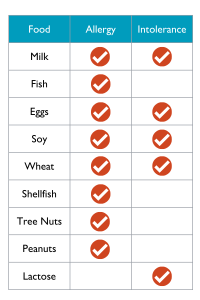GI Health, Health/Wellness, Patient Blog | May 16 2022
The difference between food allergies and intolerances

Food allergy vs intolerance
It’s important to note the difference between a food allergy and an intolerance. A food allergy can cause a wide range of symptoms created by the body’s immune system response to a particular food that your body sees as a threat. This typically happens within 30 minutes to 2 hours of eating. In some cases, the reaction can be severe or even life-threatening, such as anaphylaxis.
On the other hand, a food intolerance is usually much less severe but can still be troublesome and scary. An intolerance is often described as the feeling of the food “not agreeing with you.” When your body simply does not have the ability to digest a certain food or ingredient, it is considered a food intolerance.
Common food allergens and intolerances
As you can see, many foods can be both a food allergy and an intolerance. The difference lies in the way the body reacts to the food.

Common symptoms of a food allergy include:
- A strange sensation in the mouth or on the lips such as itching or tingling
- Nasal congestion, wheezing, and/or swelling of the throat
- Gastrointestinal issues such as diarrhea, abdominal pain, or nausea/vomiting
- Dizziness, lightheadedness, or even fainting
- Rash or hives
Common symptoms of a food intolerance include:
- Gastrointestinal discomfort including gas, heartburn, belching, vomiting, or diarrhea
- General body fatigue
- Irritability
- Acne
If you suspect a food allergy
If you suspect a food allergy because you ate something that caused a mild reaction such as an itchy throat, hives, difficulty breathing, or vomiting, it is important to see a doctor before eating that food again. You may not be sure what food or ingredient caused the reaction. However, once the food allergen is introduced to your body, you are likely to have a more severe reaction the next time you consume that food or ingredient.
A doctor or an allergist will ask you a series of questions to help narrow down what could be causing a reaction. Typically, the next step is to perform an allergy test to screen for potential food allergens. A skin or scratch test and blood tests are commonly used, but they are not 100% accurate. These tests are meant to narrow down the list of potential food allergens. Suspected allergens should be confirmed with a food elimination and challenge test.
If you suspect a food intolerance
Because a food intolerance is less severe, an elimination diet can be an effective way to self-diagnose. An elimination diet is performed over a period of two to four weeks. During this time, all potential intolerant foods are eliminated completely from the diet. For some people, this may remove many food items leaving very few “safe” foods to start. This elimination phase lasts about two weeks.
In the second phase, the suspected foods can be reintroduced one at a time for two to three days at a time. During this reintroduction phase, pay close attention to any reactions or symptoms you experience with the reintroduction of each food. Any adverse reaction may confirm a food intolerance, and you should avoid this food moving forward.
Where to find help and support
After seeing a doctor or an allergy specialist, a registered dietitian is a valuable resource for anyone who is experiencing a food allergy or intolerance, especially if you are faced with avoiding multiple foods or ingredients. The need to eliminate many foods from your diet puts you at risk for nutritional deficiency. A dietitian can help you navigate the process as well as assist you in creating a meal plan that provides you with all essential nutrients for a healthy life.
If you have more questions about food allergies or intolerances, it’s always a great idea to speak with a registered dietitian. Registered dietitians are the only credentialed experts qualified to address your unique health questions.
Note to readers: The information discussed in this blog is not intended to replace medical advice. Please meet with your physician and dietitian before making any changes to your diet.
References:
Food Allergy vs. Intolerance: What’s the Difference? Available at https://www.health.clevelandclinic.org Accessed April 13, 2022.
Food Elimination Diet. Available at https://www.foodallergy.org Accessed April 13, 2022
How to Do An Elimination Diet and Why. Available at https://www.healthline.com/nutrition/elimination-diet Accessed April 13, 2022
Who we are
Dietitians On Demand is the nationwide leader in providing dietitians with jobs they love. If flexibility, competitive pay, a full benefits package, free CPEUs each month and a team dedicated to dietitians sound good to you, apply to our positions today.




